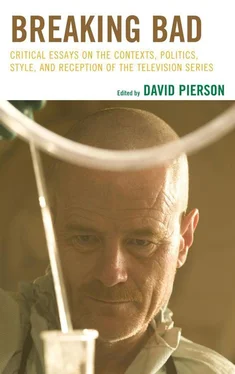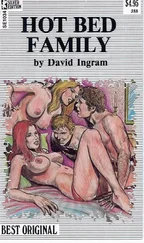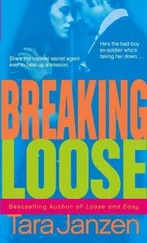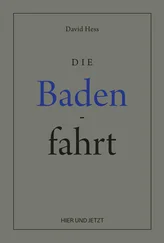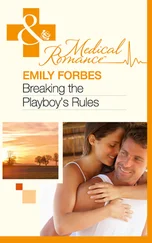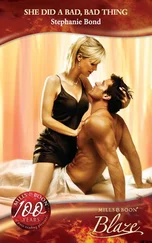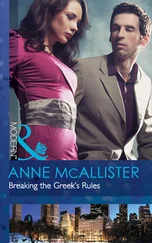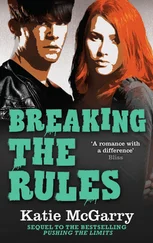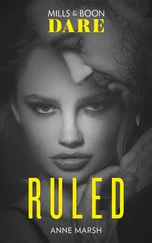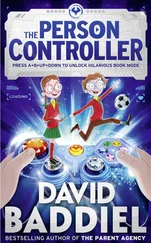As we see, this opening offers the viewer a large amount of information. From the outset, the cold open provides strangeness and disorientation. The decontextualized image of a pair of pants flying in the desert suggests unpredictability as a narrative device. Then, the surrealist image of Walter White, introduced in his underwear and with a gas mask, exhibits an absurd humor that contrasts with the gun violence and sirens announced. The explicit mark of temporality “Three weeks earlier” tells the viewer that he or she is confronted with a start in media res that corresponded to a cold open prolepsis or flash-forward. From that time on, the pilot’s teaser prepares the viewer to find more examples of decontextualized images, absurd humor and temporal disordered narrative throughout the series. The concentration of all these elements in the teaser announces to the audience that they should expect more beginnings of this kind. Finally, at the same time, this initial sequence acts as an enigma to be solved and tells the viewers they are watching a drama committed to formal experimentation.
Throughout the whole series, Breaking Bad shows a pronounced tendency toward the use of extreme close-up shots. This inclination for revealing extreme detail is not a purely aesthetic decision but part of a narrative intention as seen by looking at the original scripts of the series. [3] Scripts available on www.scriptcity.com .
For example, on the script of the episode “No Mas” (03/21/10), when the characters of The Cousins are introduced, the text says: “As we TRACK LOW with The Cousins, we note their distinctive, hand-tooled COWBOY BOOTS. We watch as their SILVER TOE-CAPS press into the dried mud, leaving IMPRINTS” (2). As seen from the writing of the show, the series gives special attention to detail
In most cases, we can see extreme close-ups on individual objects that contrast with the open wide shots of the desert of New Mexico, another aesthetic brand of the show that seems to be an homage to Sergio Leone’s spaghetti westerns, especially The Good, The Bad, and The Ugly (1966), and Once Upon a Time in the West (1968). In fact, Leone’s visual style is a reference for the directors of the series as Vince Gilligan [4] Please see the interview at http://blogs.amctv.com/breaking-bad/2011/10/vince-gilligan-interview.php .
and Michael Slovis, [5] Please see the interview at Indiewire.com. http://www.indiewire.com/article/television/michael-slovis-interview-breaking-bad-director-of-photography .
Breaking Bad ’s director of photography, have confirmed on many occasions. Slovis has admitted that Gilligan and him tried to convince AMC and Sony Entertainment, the production company, to shoot the series in widescreen, like a Leone movie. Both the open wide shots and the extreme close-ups in Breaking Bad have the same purpose creating images out of context, along with constructing undefined and ultimately ambiguous frames. The wide shots serve to contextualize the action but they make it impossible to distinguish the details in the small size of the television screen. This lack of information generates in the viewer the uncertainty of not knowing what is happening in the frame. The same occurs in the opposite situation, the excess detail of the extreme close-up accurately identifies the object but makes understanding the context impossible so the information becomes, in the same way, incomplete.
The disorientation of the viewer is a recurrent strategy in contemporary narrative television, as Jason Mittell (2006, 2010) has observed. The creation of intentionally vague images, difficult to contextualize in the parameters of space and time, has proliferated in the last decade in American television producing more complex narratives. These strategies, which Mittell (2006) calls “narrative special effects,” not only arrests the audience’s attention, but serve to make visible the mechanics of narration. Despite the fact that classic TV series were also familiar with temporal and spatial alterations, these narrative devices were introduced to the viewers by means of an obvious exposition. In contemporary complex TV drama, however, orienting clues are obviated in order to produce images of ambiguity. Series such as Lost (ABC, 2004-2010), 24 (Fox, 2001-2010), or Battlestar Galactica (Sci-Fi, 2003-2009) have frequently produced such complex images. For that reason, as Mittell (2006) points out, “narratively complex programming invites audiences to engage actively at the level of form” (38). These kinds of fictions present their narration as a complex puzzle and audiences receive pleasure to trying to solve it.
In the case of Breaking Bad complexity is revealed through the ambiguity of decontextualized images, most of which are concentrated in the cold open sequences. The series uses the episode beginnings to generate confusing images through extreme close-ups. There are clear examples of this narrative practice in a number of episodes from the series’ second season. An example of this practice is the series of episodes of the second season, “Seven Thirty-Seven” (03/08/09), “Down” (03/29/09), “Over” (05/10/09) and “ABQ” (05/31/09). Each of these episodes begins with images corresponding to a black and white sequence which the viewer may not make sense of until the end of the season. The episode “Seven Thirty-Seven” opens with a close-up of a hose dripping, which is followed by the shot of a light and a snail crawling on a wall. The opening then reveals an eye floating in a pool and then a pink teddy bear—the only object with color in all the sequence—slightly battered and with one eye missing. With that image of the teddy bear under water the narration is interrupted to give way to the opening credits of the series and, after them, the story continues where we had left it at the end of the first season, with Tuco doing business with Walt and Jesse at an auto junkyard.
The confusion for the viewer is formidable. From the images previously shown it becomes impossible to determine where and when that sequence occurs. Both could be a flashback and a flash-forward, or even a dream sequence. The succession of decontextualized close-ups increase the audience’s interest in what they are seeing, so they look for immediate answers. The episode, however, concludes without offering any guide and in the two following episodes there is no reference to those strange images. During that wait, expectations and uncertainty escalates. Not until the fourth episode of the season, “Down,” will the series return to the black and white sequence. In this case, returning to the previous image of the pink teddy bear the teaser adding the silhouette of a human figure pulling the stuffed toy out of the water and places it in a plastic bag. The opening sequence ends with a close-up of glasses similar to those used by the character of Walter White. In the episode “Over,” six episodes later, the sequence reappears again. This time the above information is followed by a shot of the entrance to Walter’s home where we can see his car. At this point we can confirm that the objects previously seen were located in Walter’s backyard. This time, the latest image of the teaser shows two corpses in a bag. As we can see, new information is being added gradually with each teaser, however, the sequence remains ambiguous, indefinite.
The last episode of the season, “ABQ,” includes more details of that sequence, including a sign reading “Evidence. Do not remove,” which confirms that we actually are at the scene of an incident under investigation. It is not until the end of the episode, however, that the main story finally connects with these decontextualized images and it is revealed that it was a flash-forward focused on the consequences of a crash. Only now, with the complete information, the viewer is able to restore the meaning of each image seen in previous episodes. The use of the close-up shot encourages a conscious strategy of concealment. Instead of showing the general scenario of waste and damage caused by the crash, the series pays attention to the slightest detail creating a vast and unreachable off scene. This mise-en-scène presumes, eventually, a space fragmentation. The previous teasers offer a succession of images juxtaposed, between which there is not a connecting thread. This strategy of juxtaposition and fragmentation is a common occurrence throughout the entire series, as discussed below.
Читать дальше
